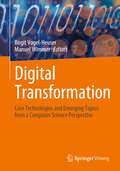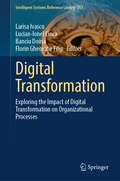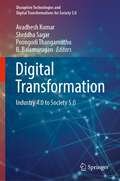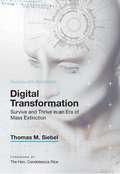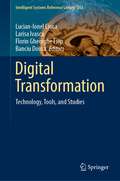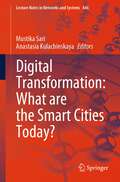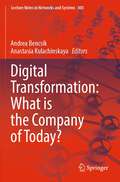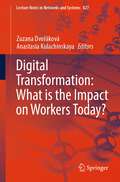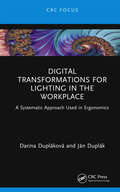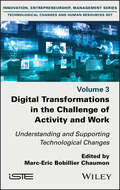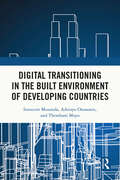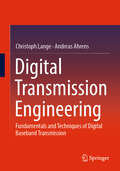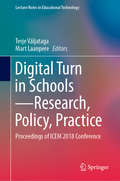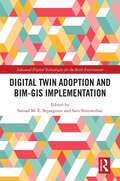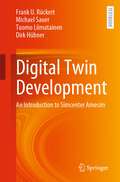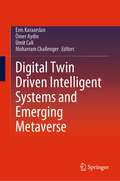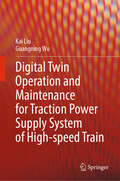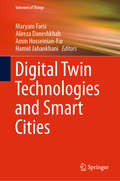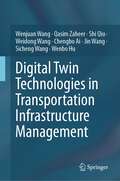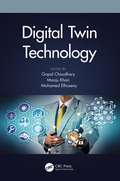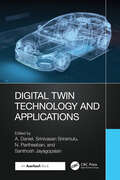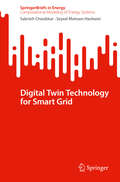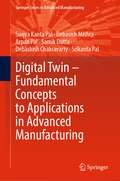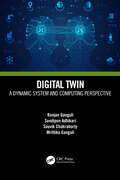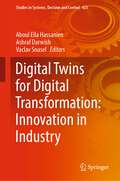- Table View
- List View
Digital Transformation: Core Technologies and Emerging Topics from a Computer Science Perspective
by Manuel Wimmer Birgit Vogel-HeuserDigital Transformation in Industry 4.0/5.0 requires the effective and efficient application of digitalization technologies in the area of production systems. This book elaborates on concepts, techniques, and technologies from computer science in the context of Industry 4.0/5.0 and demonstrates their possible applications. Thus, the book serves as an orientation but also as a reference work for experts in the field of Industry 4.0/5.0 to successfully advance digitization in their companies.
Digital Transformation: Exploring the Impact of Digital Transformation on Organizational Processes (Intelligent Systems Reference Library #257)
by Florin Gheorghe Filip Larisa Ivascu Lucian-Ionel Cioca Banciu DoinaThe book offers aspects related to the health and process safety field, complex approaches to artificial intelligence, the role of accounting and auditing in the digital age, DT in agriculture, artificial intelligence in the maritime domain, education, management, sustainability and mobile technologies in learning. Digitization, digitalization and digital transformation (DT) are important for public organizations and private organizations. Despite their importance, these steps are approached differently in organizations. Public organizations emphasize the importance of digital transformation, while public organizations make efforts to align themselves with citizens' demands from a digitalization perspective. Incorporating technologies into organizational processes has become a priority for all industries to lead to important changes. All these activities are covered by the digital transformation that can lead to increased efficiency, agility, innovation and the unlocking of organizational values. Through this complex approach, the book contributes to the completion of knowledge in the field of digital transformation, develops and anticipates new research directions. It is addressed to professionals, practitioners, researchers, students and other interested parties.
Digital Transformation: Industry 4.0 to Society 5.0 (Disruptive Technologies and Digital Transformations for Society 5.0)
by B. Balamurugan Avadhesh Kumar Shrddha Sagar Poongodi ThangamuthuThis book focuses on computing for Industry 4.0 illustrating different domains with the purpose of integration with existing domains for automation of processes. It gives readers an idea about the various challenges and design structure for computing of Industry 4.0. The contents include contributions from experts in Cyber-Physical Systems (CPS), the Internet of Things (IoT), Industrial Internet of Things (IIoT), cloud computing, cognitive computing, and artificial intelligence across the world, contributing their knowledge to identify the different characteristics of the above domains.
Digital Transformation: Survive and Thrive in an Era of Mass Extinction
by Thomas Siebel<p>From visionary Silicon Valley entrepreneur Tom Siebel comes a penetrating examination of the new technologies that are disrupting business and government—and how organizations can harness them to transform into digital enterprises. <p>The confluence of four technologies—elastic cloud computing, big data, artificial intelligence, and the internet of things —writes Siebel, is fundamentally changing how business and government will operate in the 21st century. <p>Siebel masterfully guides readers through a fascinating discussion of the game-changing technologies driving digital transformation and provides a roadmap to seize them as a strategic opportunity. He shows how leading enterprises such as Enel, 3M, Royal Dutch Shell, the U.S. Department of Defense, and others are applying AI and IoT with stunning results. <p>Digital Transformation is the guidebook every business and government leader needs to survive and thrive in the new digital age.</p>
Digital Transformation: Technology, Tools, and Studies (Intelligent Systems Reference Library #253)
by Florin Gheorghe Filip Larisa Ivascu Lucian-Ionel Cioca Banciu DoinaThis book presents a multidisciplinary approach to digital transformation process of organizational transformation, offering support throughout the implementation process to all those interested. The digital transformation (DT) is a priority for many companies in the context of technological evolution. The use of appropriate tools, methodologies, methods, approaches, and techniques for DT, depending on the organizational characteristics, can contribute to a complete approach to organizational processes and to their efficiency. Digital transformation involves the adoption and use of new digital technologies to develop new products and services, modify existing ones and develop new business models to increase efficiency, productivity, and competitiveness. Starting from marketing to culture and education to health, automotive, engineering, mobility and human resources and others, it is addressed to professionals, practitioners, researchers, students, and other interested parties.
Digital Transformation: What are the Smart Cities Today? (Lecture Notes in Networks and Systems #846)
by Anastasia Kulachinskaya Mustika SariThis book presents various models and approaches, specific proposals, and recommendations on a whole range of areas for smart cities' development. This book proposes to look at the problem through a broad overview of all elements of a smart city as a single system: smart governance, smart buildings, smart transportation, smart tourism destinations, smart economy, and smart environment. The book is intended for both young and experienced scientists who want to get acquainted with the latest trends and data for using them in their research.
Digital Transformation: What is the Company of Today? (Lecture Notes in Networks and Systems #805)
by Anastasia Kulachinskaya Andrea BencsikThis book offers the latest research on organizational management, knowledge management, organizational functioning, organizational digitalization, and other issues of modern company development. The book proposes to look at the pool of these problems through the prism of building various models for implementing digital transformation of business and processes. This book is intended for both young and experienced scientists who want to get acquainted with latest trends and data to use them in their research.
Digital Transformation: What is the Impact on Workers Today? (Lecture Notes in Networks and Systems #827)
by Zuzana Dvořáková Anastasia KulachinskayaThis book offers the latest research on formation of modern workers in the context of digitalization: from constant improvement of new training technologies to growing requirements for employees in workplace, as well as an assessment of specialists' digital skills and dynamics of changes over the past years. The book proposes to look at the pool of these problems through the prism of acquisition of new digital competencies and requirements for a modern worker. This book is intended for both young and experienced scientists who want to get acquainted with latest trends and data to use them in their research.
Digital Transformations for Lighting in the Workplace: A Systematic Approach Used in Ergonomics
by Darina Dupláková Ján DuplákDigital Transformations for Lighting in the Workplace: A Systematic Approach Used in Ergonomics offers a practical concept for the implementation of digital transformation in ergonomics in work settings. It specifically focuses on providing information about illumination in production and non-production fields, and the described design solutions are applicable in practice. The concepts can be used in a typical manufacturing workplace or an academic setting. The methods in the book complement the modern trend to digitalise the workplace, making the research and practical outcomes of this book compatible with the concept of Industry 4.0 - Digital Manufacturing. This title offers a systematic approach to the field of digital transformation for ergonomics. It presents an opportunity for the reader to learn to create a digital model for lighting by analysing mathematical models for calculation through formulas and simulation algorithms. To put learning into context, this book provides two case studies from the production and non-production sectors, including an example of a classroom. The reader will then be able to utilise the methods to create their own digitized illumination system. This monograph is an ideal read for academics and researchers working at universities in the field of Ergonomics and professionals in industrial management including those in manufacturing plants, ergonomists, designers from the industry sector, or people who are interested in ergonomics, digitization, and simulation of a working environment.
Digital Transformations in the Challenge of Activity and Work: Understanding and Supporting Technological Changes
by Marc-Eric Bobillier ChaumonTECHNOLOGICAL CHANGES AND HUMAN RESOURCES SET Coordinated by Patrick Gilbert The accelerating pace of technological change (AI, cobots, immersive reality, connected objects, etc.) calls for a profound reexamination of how we conduct business. This requires new ways of thinking, acting, organizing and collaborating in our work. Faced with these challenges, the Human and Social Sciences have a leading role to play, alongside others, in designing, supporting and implementing these digital transformation projects. Their ambition is to participate in the development of innovative and empowering devices, that is to say, systems that are truly at the service of human beings and their activity, that empower these professionals to take action and that also provide occupational health services. This book takes a multidisciplinary look at the challenges of these digital transformations, making use of occupational psychology, ergonomics, sociology of uses, and management sciences. This viewpoint also helps provide epistemological, methodological and empirical insights to better understand and support the changes at work.
Digital Transitioning in the Built Environment of Developing Countries
by Innocent Musonda Adetayo Onososen Thembani MoyoThis book serves as a helpful guide for anyone interested in understanding and implementing Building Information Modelling (BIM) in developing countries. It focuses on the construction industry and how digital technologies can improve the way buildings and infrastructure projects are planned, designed, and built. The book starts by explaining what BIM is and why it's important. It then explores the challenges that developing countries face when adopting BIM, such as limited resources and lack of infrastructure. The authors provide practical solutions to overcome these challenges based on real-world examples and case studies. The book takes readers through a step-by-step process to create a roadmap for BIM adoption. It helps readers understand the necessary steps and strategies involved, such as setting clear goals, involving all relevant stakeholders, and managing changes in the way things are done.One of the book's unique features is that it focuses specifically on the needs and circumstances of developing countries. It recognises that these countries have different challenges compared to more developed nations. By addressing these specific challenges, the book provides tailored advice that readers can apply in their own contexts. The book also emphasises the need for training and capacity building. It acknowledges that many professionals in developing countries may not have the necessary skills and knowledge to fully utilise BIM. Therefore, it introduces an approach called the dynamic capacity model, which helps ensure that people receive the training they need to successfully implement BIM. Overall, this book is a practical and accessible resource for anyone interested in implementing BIM in the construction industry of a developing country. It is important reading for professionals and academics in construction management, engineering, architecture, infrastructure development, urban planning, and governance in developing nations.
Digital Transmission Engineering: Fundamentals and Techniques of Digital Baseband Transmission
by Christoph Lange Andreas AhrensThis textbook introduces the transmission of digital signals over disturbed channels, emphasizing an intuitive and mathematically grounded explanation of baseband transmission. It recaps essential fundamentals of signal and system theory and explores functional interdependencies in baseband transmission to advance the understanding of baseband transmission concepts. The wired transmission using copper cable is highlighted as an important transmission technique. The copper cable’s transmission characteristics are described using classical electrical engineering and system theory methods. Baseband techniques are applied to the transmission over the linearly distorting channel copper cable, with discussions on filtering and equalization. The textbook includes detailed derivations, numerical examples, solved exercises and various illustrations.
Digital Turn in Schools—Research, Policy, Practice: Proceedings of ICEM 2018 Conference (Lecture Notes in Educational Technology)
by Mart Laanpere Terje VäljatagaThis volume is a compilation of selected papers that were presented at the annual conference of the International Council of Educational Media (ICEM) in Tallinn, Estonia, on September 5 - 7, 2018. The book reports on recent interdisciplinary research and innovative practices regarding school-wide implementation of digital innovation and connects it with recent developments in the field of educational media. The key concept is “Digital Turn,” which is understood as a socio-technical transition towards next-generation digital learning ecosystems in education. Although Digital Turn can also be implemented at the classroom or national levels, most of the contributions in this volume take a whole-school perspective on the policies and practices regarding digital innovation, educational media, e-assessment, digital competences of teachers and students as well as learning design and learning analytics.
Digital Twin Adoption and BIM-GIS Implementation (Advanced Digital Technologies for the Built Environment)
by Sepasgozar, Samad M. E. Sara ShirowzhanThe aim of this edited book volume is to present new concepts, and applications of Digital Twin and relevant tools in the built environment context. The book identifies key organisational factors that influence the adoption of technology within the architectural service industry, setting the stage for a deeper understanding of the shift towards digital methodologies.The book introduces the Digital Twin Readiness Level framework, a modified metric system with ten levels of risk‑based maturity and an empirical development of a Digital Twin Adoption Model. Furthermore, the text ventures into immersive virtual environments and their applications, showcasing innovative practices that enhance learning and operational efficiency.Additionally, the book examines the integration of Building Information Modelling (BIM) and Geographic Information Systems (GIS), revealing new workflows for creating 3D models of cities. A focus on Australia’s government‑funded infrastructure projects offers insights into the values and acceptance criteria for these technologies, providing a comprehensive overview of their practical implications and future potential. This book is essential reading for practitioners, engineers, and managers involved in any phase of the built environment from design to operation and other architectural, engineering, and construction (AEC) stakeholders who are a part of digital transformations, as well as researchers, educators, and students interested in the field.
Digital Twin Development: An Introduction to Simcenter Amesim
by Michael Sauer Frank U. Rückert Tuomo Liimatainen Dirk HübnerCreating a digital twin should be easy and intuitive. This book presents twins from different technical fields and describes in detail how to build them. The book is aimed at students or young engineers who want develop and modify the twins without much prior knowledge. The use of the free software tool Simcenter Amesim is introduced. Simcenter Amesim belongs today to the industry standard for the development of digital twins. This program was chosen because it is easy to learn and does not require deep mathematical knowledge or programming skills. We start by creating a simple calculator, then model, for example, mechanical twins such as falling balls, ventilation and tank systems, pipelines, or a solar collector. The physical background is explained for each simulation example, and each simulation example concludes with suggestions for further work. This enables the reader to perform further investigations and exercises with the digital twins.
Digital Twin Driven Intelligent Systems and Emerging Metaverse
by Enis Karaarslan Ömer Aydin Ümit Cali Moharram ChallengerThis book covers the notion of the digital twin, which has the potential to alter the way systems are governed and manufactured. It also addresses the metaverse as an emerging technology with its roots in literature, cross-platform avatars, and artificial intelligence-oriented cybersecurity issues. The untapped potential of the metaverse and digital twins as enabling technologies for the next-generation industries is emphasized in various chapters. Digital twin technology enables manufacturers to comprehend their products throughout product design better, integrate simulation, tracking, and optimization in real-time, and appropriately analyze operations. Especially for complicated products or systems, testing on a digital twin is more efficient (more accessible, quicker, less error-prone, and less expensive). The product is examined in its virtual version before it is displayed in the actual world. Additionally, the digital twin minimizes operational expenses and increases the longevity of equipment and assets. By prolonging the life of the thing, they represent and enhance its working efficiency; it may minimize operating costs and prospective capital spending. The digital twin idea is becoming a reality as it has begun to be used in several industries, including energy, manufacturing, construction, transportation, aerospace, smart cities, healthcare, cyber security, finance, and agriculture. Academic and industrial experts highlighted the most compelling use cases of digital twins and metaverses and the challenges inherent in their implementation. Readers who want to make more effective systems will find the book useful. Also, people who want to get an idea and vision of how technology will change our lives will benefit from this book.
Digital Twin Operation and Maintenance for Traction Power Supply System of High-speed Train
by Kai Liu Guangning WuThis book comprehensively and systematically introduces the research and application of digital twin operation and maintenance technology for high-speed train traction power supply system. The book is divided into six chapters, which introduce the digital twin architecture of high-speed train traction power supply system, digital twin modeling of power supply system, multi-physical field digital twin of train key equipment, digital twin of typical train scenarios, and digital twin operation and maintenance of train traction power supply system. This book is novel and focused, the whole book is oriented to the actual engineering problems, covering the theoretical frameworks, model building, data analysis, and application practice. It extensively describes digital twin modeling and intelligent operation and maintenance methods for high-speed train traction power supply systems, proposing a novel approach of digital twin intelligent operation and maintenance based on deep learning image recognition, aiming to ensure the safe operation of high-speed trains. It could be serve as a reference book for graduate students and professionals in rail transit and power engineering.
Digital Twin Technologies and Smart Cities (Internet of Things)
by Hamid Jahankhani Amin Hosseinian-Far Maryam Farsi Alireza DaneshkhahThis book provides a holistic perspective on Digital Twin (DT) technologies, and presents cutting-edge research in the field. It assesses the opportunities that DT can offer for smart cities, and covers the requirements for ensuring secure, safe and sustainable smart cities. Further, the book demonstrates that DT and its benefits with regard to: data visualisation, real-time data analytics, and learning leading to improved confidence in decision making;reasoning, monitoring and warning to support accurate diagnostics and prognostics;acting using edge control and what-if analysis; andconnection with back-end business applications hold significant potential for applications in smart cities, by employing a wide range of sensory and data-acquisition systems in various parts of the urban infrastructure. The contributing authors reveal how and why DT technologies that are used for monitoring, visualising, diagnosing and predicting in real-time are vital to cities’ sustainability and efficiency. The concepts outlined in the book represents a city together with all of its infrastructure elements, which communicate with each other in a complex manner. Moreover, securing Internet of Things (IoT) which is one of the key enablers of DT’s is discussed in details and from various perspectives. The book offers an outstanding reference guide for practitioners and researchers in manufacturing, operations research and communications, who are considering digitising some of their assets and related services. It is also a valuable asset for graduate students and academics who are looking to identify research gaps and develop their own proposals for further research.
Digital Twin Technologies in Transportation Infrastructure Management
by Jin Wang Weidong Wang Wenjuan Wang Qasim Zaheer Shi Qiu Chengbo Ai Sicheng Wang Wenbo HuThis book reveals the power of digital twin technologies in terms of optimizing the performance and maintenance of infrastructure assets. From roads, bridges, and tunnels to airports and smart cities, it will guide you through the latest advances in and use cases on this cutting-edge technology. You will come to understand the challenges involved in the development of digital twins and learn about the initiatives and projects underway to overcome them. Explore the potential of this technology in terms of reducing costs, improving system performance, and enhancing the overall infrastructure experience for users. Get ready to embark on a journey of understanding the future of transportation infrastructure management with digital twin technologies.
Digital Twin Technology
by Mohamed Elhoseny Manju Khari Gopal ChaudharyMost of the business sectors consider the Digital Twin concept as the next big thing in the industry. A current state analysis of their digital counterparts helps in the prediction of the future of physical assets. Organizations obtain better insights on their product performance through the implementation of Digital Twins, and the applications of the technology are frequently in sectors such as manufacturing, automobile, retail, health care, smart cities, industrial IoT, etc. This book explores the latest developments and covers the significant challenges, issues, and advances in Digital Twin Technology. It will be an essential resource for anybody involved in related industries, as well as anybody interested in learning more about this nascent technology. This book includes: The future, present, and past of Digital Twin Technology. Digital twin technologies across the Internet of Drones, which developed various perceptive and autonomous capabilities, towards different control strategies such as object detection, navigation, security, collision avoidance, and backup. These approaches help to deal with the expansive growth of big data solutions. The recent digital twin concept in agriculture, which offers the vertical framing by IoT installation development to enhance the problematic food supply situation. It also allows for significant energy savings practices. It is highly required to overcome those challenges in developing advanced imaging methods of disease detection & prediction to achieve more accuracy in large land areas of crops. The welfare of upcoming archetypes such as digitalization in forensic analysis. The ideas of digital twin have arisen to style the corporeal entity and associated facts reachable software and customers over digital platforms. Wind catchers as earth building: Digital Twins vs. green sustainable architecture.
Digital Twin Technology and Applications
by Srinivasan Sriramulu A Daniel N Partheeban Santhosh JayagopalanThe Fourth Industrial Revolution is being accelerated by the digital twin technological revolution, which converges intelligent technologies and defines the connectivity between physical and digital items. The Internet of Things (IoT) connects the real and digital worlds, allowing connected items to deliver a vast array of services to internet users. IoT devices create large amounts of data that may be fed into AI systems for decision- making. In a decentralized architecture, digital twin technology may be utilized to protect platforms and create smart contracts. Digital twins decentralized ledger, immutability, self- sovereign identification, and consensus procedures hold a lot of promise for improving AI algorithms. Furthermore, leveraging smart contracts in a digital twin system to facilitate user interaction via IoT might have a big influence, and this integrated platform is expected to revolutionize many fields.Digital Twin Technology and Applications examines the problems, issues, and solutions for using big data to enable streaming services using IoT and AI with digital twin technology. The IoT network concept is the key to success, and to establish a solid IoT platform on which large data transmission may take place, it must handle protocol, standards, and architecture. The book provides insight into the principles and techniques of IoT and AI. It explores the idea of using blockchain to provide security in a variety of sectors. The book also covers the application of integrated technologies to strengthen data models, improve insights and discoveries, innovate audit systems, as well as digital twin technology application to intelligent forecasting, smart finance, smart retail, global verification, and transparent governance.
Digital Twin Technology for Smart Grid (SpringerBriefs in Energy)
by Sabrieh Choobkar Seyed Mohsen HashemiThe traditional power grid has been revolutionized in recent years, and its different domains are improving to form a new smart grid. To better understand smart electricity grid and recommend how its domains function best, a comprehensive look at the power system in parallel with digitalization revolution is required. Recent digital twin (DT) technology promises to enhance industries, including smart grids, and this book studies DT architecture and its applications and benefits. Coverage includes DT solutions for smart grid domains and subsystems and describes advantages of employing DT in the smart grid. The book&’s concept is based on merging DT technology with smart grid applications. Its structure follows an understanding of DT concepts and applications in smart grid domains. Digital Twin Technology for Smart Power Grid will be a valuable reference for power industry practitioners, researchers, and students. It explains the new digital twin technology and how it can enhance the current electricity system toward a smarter power grid.
Digital Twin – Fundamental Concepts to Applications in Advanced Manufacturing (Springer Series in Advanced Manufacturing)
by Surjya Kanta Pal Debasish Mishra Arpan Pal Samik Dutta Debashish Chakravarty Srikanta PalThis book provides readers with a guide to the use of Digital Twin in manufacturing. It presents a collection of fundamental ideas about sensor electronics and data acquisition, signal and image processing techniques, seamless data communications, artificial intelligence and machine learning for decision making, and explains their necessity for the practical application of Digital Twin in Industry.Providing case studies relevant to the manufacturing processes, systems, and sub-systems, this book is beneficial for both academics and industry professionals within the field of Industry 4.0 and digital manufacturing.
Digital Twin: A Dynamic System and Computing Perspective
by Ranjan Ganguli Sondipon Adhikari Souvik Chakraborty Mrittika GanguliThe digital twin of a physical system is an adaptive computer analog which exists in the cloud and adapts to changes in the physical system dynamically. This book introduces the computing, mathematical, and engineering background to understand and develop the concept of the digital twin. It provides background in modeling/simulation, computing technology, sensor/actuators, and so forth, needed to develop the next generation of digital twins. Concepts on cloud computing, big data, IoT, wireless communications, high-performance computing, and blockchain are also discussed. Features: Provides background material needed to understand digital twin technology Presents computational facet of digital twin Includes physics-based and surrogate model representations Addresses the problem of uncertainty in measurements and modeling Discusses practical case studies of implementation of digital twins, addressing additive manufacturing, server farms, predictive maintenance, and smart cities This book is aimed at graduate students and researchers in Electrical, Mechanical, Computer, and Production Engineering.
Digital Twins for Digital Transformation: Innovation in Industry (Studies in Systems, Decision and Control #423)
by Ashraf Darwish Vaclav Snasel Aboul Ella HassanienThis book aims to present dominant applications and use cases of the fast-evolving DT and determines vital Industry 4.0 technologies for building DT that can provide solutions for fighting local and globalmedical emergencies during pandemics. Moreover, it discusses a new framework integrating DT and blockchain technology to provide a more efficient and effective preventive conservation in different applications.
